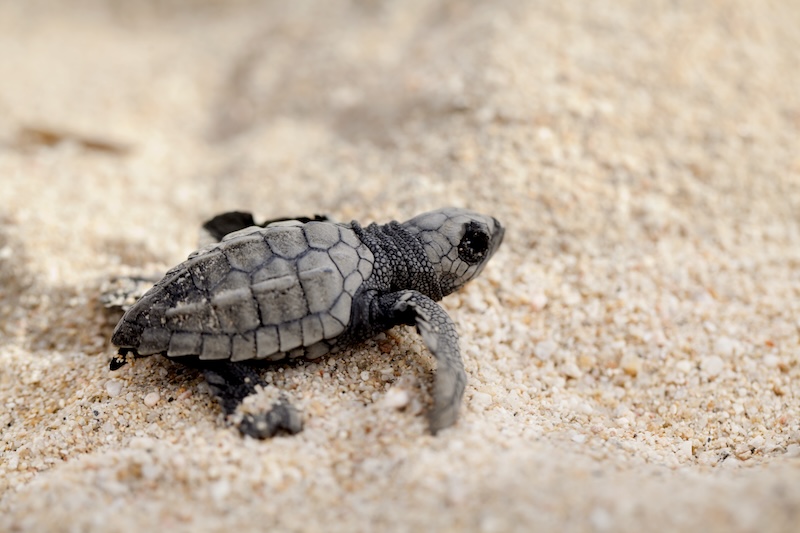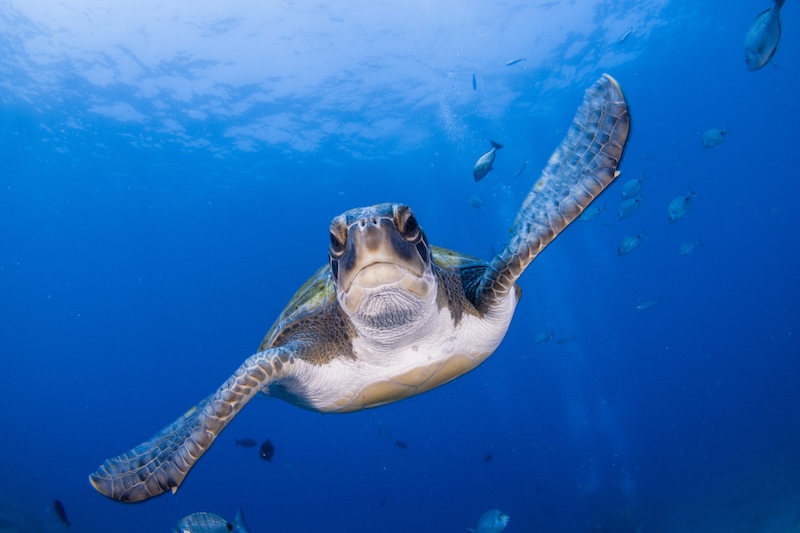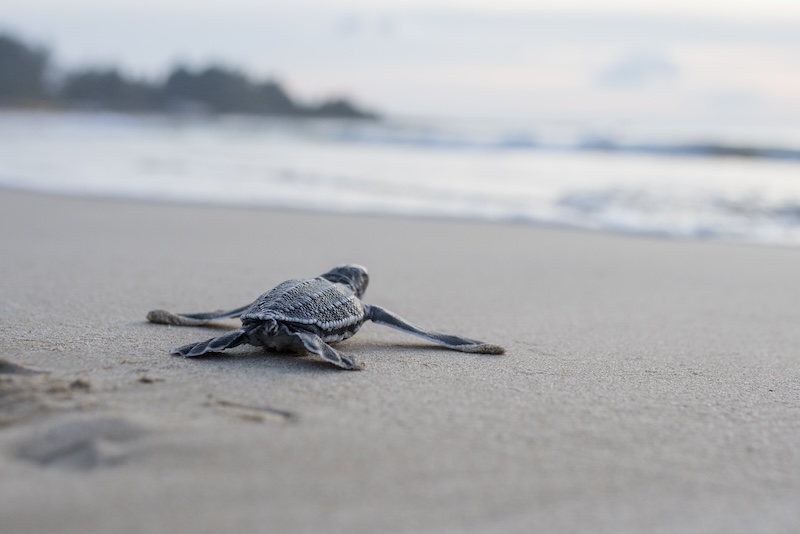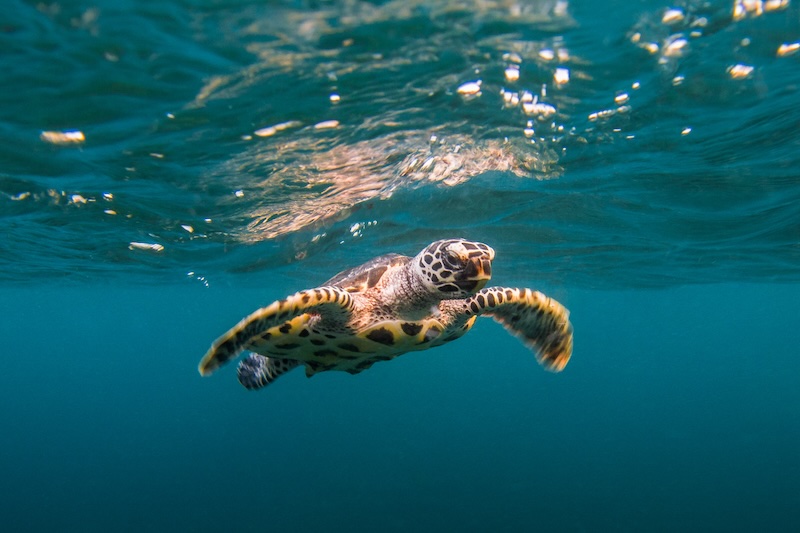Turtles in the UAE: how you can help these endangered creatures
We’re all accountable for the safety of these little heroes in a half-shell…
Documentary voice over: “The UAE may sit within a desert expanse, experiencing scorching summer temperatures alongside scant annual rainfall – but to write this land of steel and sand off as lifeless, would be a grievous fault. Even amongst its towering dunes and sparkling city streets, nature finds a way to thrive. And if we dip our heads below the Gulf’s waterline, we find one of the most abundant regional habitats of all.”
There are struggles though, one of our most beloved visitors – the sea turtle – faces an uncertain future. It’s survival depends on projects like The Wildlife Rescue Program, conceived by a collaborative partnership between The Environment Agency – Abu Dhabi (EAD) and The National Aquarium (TNA). And it seems to be working.









A tiny olive ridley sea turtle crawling on sand
Close-up of baby olive ridley sea turtle (Lepidochelys olivacea), also known as the Pacific ridley, on beach sand. Selective focus on baby turtle.
Green turtle (Chelonia mydas)
Green Turtle
Leather back turtle babies are released into the sea
Leatherback turtle babies are released into the sea
Baby hawksbill sea turtle swims with reflection
A juvenile hawksbill sea turtle (Eretmochelys imbricata) swims under the water surface with reflection in the evening, Koh Tao, Suratthani, Thailand.
The partnership has just marked its landmark 1,000th rescue turtle – set for release in the summer of 2024. To find out more about these varied-aged, cute and verdant turtles (description purely for TMNT theme song referencing), and how we can play a part in ensuring they’ll still be around for our children, we spoke to one of TNA’s turtle gurus: Natassia Mannina Wildlife Rescue Veterinarian at The National Aquarium.
Which species of turtles are visiting UAE shores?
At The National Aquarium Abu Dhabi, our most frequent interactions come from green turtles, Hawksbill, and Loggerheads. While Leatherback and Olive Ridley also have been spotted in the UAE, they are a rare sight. All seven global species of sea turtles are classified as endangered or nearly threatened, so all require priority attention when they are found.
How long do these turtles live and how far do they travel?
The average lifespan of turtles is about 50-100 years, and the longest travel recorded was a Leatherback which made a journey of 20,558 km (ed: that’s more than half the circumference of the earth). From our own satellite tracking data, we’ve observed that all of our turtles have stayed in the Arabian Gulf, with the longest travel times clocked up by Hawksbills and Loggerheads going to Iran and back. Which is approximately 800km.
Which locations in the UAE are the best for spotting turtles?
The waters around Saadyiat Island and Fujairah are good places to see turtles, as we know regular nesting occurs in these locations. The nesting season is from March to June.
The best way to protect the turtles is to build a more sustainable lifestyle. Cutting out plastics by using reusable bags, utensils, and other products whenever possible, choosing biodegradable and sustainable brands and teaching children to make a difference and protect nature and animals. Only if we act together as a community, we will be able to make a difference.
What does the timeline of care look like on a standard rehabilitation project, from capture to release?
During the winter season, turtle recovery takes between three-to-four months. The first few days they stay in individual tanks, we provide them with fluids, antibiotics, and vitamins. After two or three day, we usually start to see the early stages of recovery. From there, the turtles will be given a mix of seafood with vitamins and probiotics until they gain enough weight and go to a larger lagoon to continue their rehabilitation. Our team at Wildlife Rescue follows their progress and monitors the entire process. When the summer comes, and they are fully recovered, the team releases them back to the sea. In specific cases, some animals were caught in the fish nets or experienced trauma from human interaction. These turtles tend to be healthy but extremely tired, so we give them time to rest, and support their health with antibiotics and nutrient-rich food, allowing them to recover much faster.
What can people to do support conservation projects here in the UAE?
Aside from leading a sustainable lifestyle, you can join beach cleaning initiatives in your city, or join organisations that take care of the environment. If you spot an injured animal on the beach, please report the case to the EAD through the Abu Dhabi Government Contact Centre at 800555 or 0567624246.
Can you share with us your top three turtle facts please?
- Turtles can hold their breath for up to four hours. As air breathers, they must come up to the surface or they run the risk of drowning.
- Turtles have ‘spines’ in their throat called ‘esophageal papillae’ which hold the food when they vomit water. The muscle movements hold the food in the esophagus to digest.
- Scientists believe that turtles have a really good memory. They return to the beach where they were born om to nest because of visual and smell memory.
For more information and safe, up-close interactions with The Gulf’s native turtle species, head to The National Aquarium, Al Qana, Abu Dhabi, tickets from Dhs110. thenationalaquarium.ae
Images: Getty
